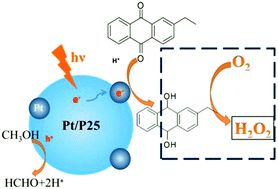Photocatalytically green synthesis of H2O2 using 2-ethyl-9,10-anthraquinone as an electron condenser†
Abstract
A high level (∼9 mM) of hydrogen peroxide is photocatalytically synthesized by using O2 as an oxidant and 2-ethyl-9,10-anthraquinone (EAQ) as an electron condenser. The photo-catalytic efficiency of the EAQ-assisted H2O2 production is ca. 10-fold higher than that of H2 generation with Pt/P25.


 Please wait while we load your content...
Please wait while we load your content...